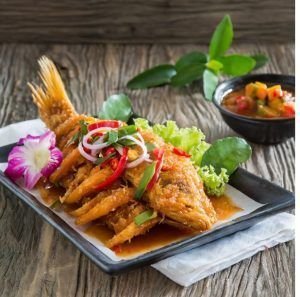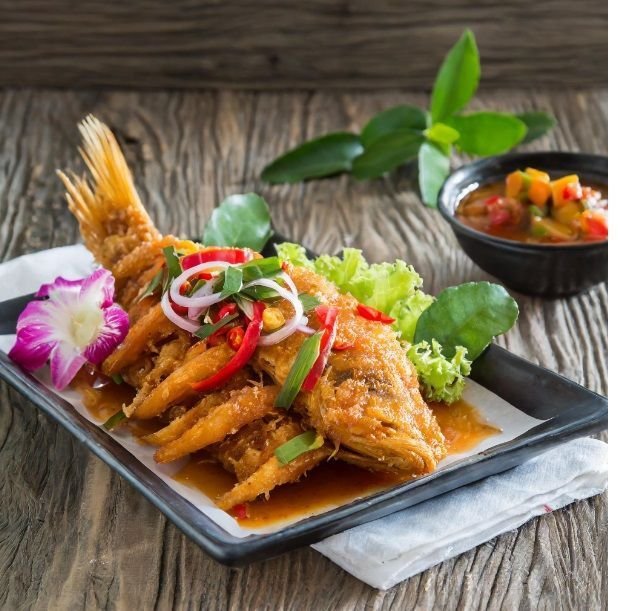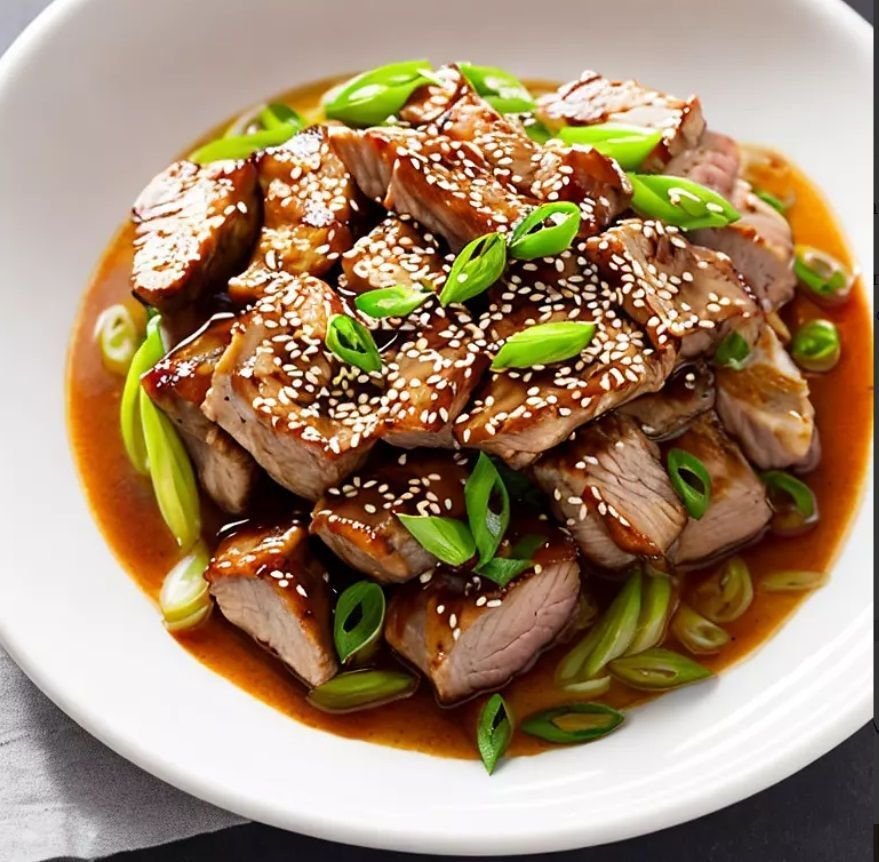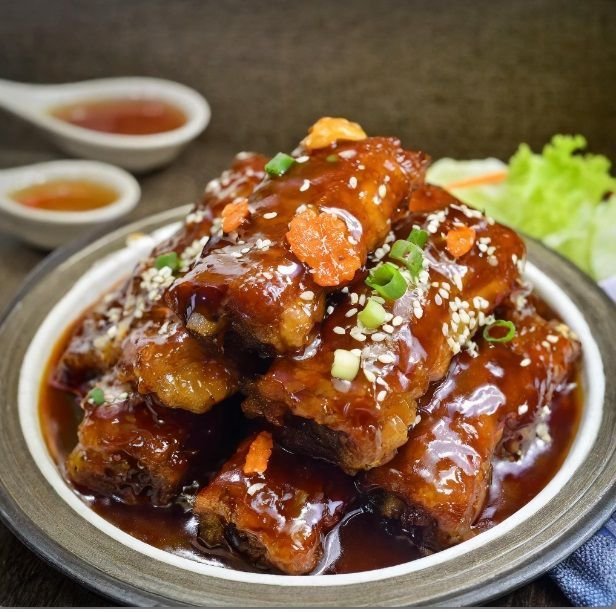Deep fried sweet-and-sour fish
Deep fried sweet-and-sour fish
Deep Fried Sweet-and-Sour Fish: A Classic Recipe from East China. Chinese Cuisine.
Ingredients:
For the Fish:
- 2 whole fish (such as tilapia or sea bass), cleaned and scaled
- Salt and pepper to taste
- 1 cup cornstarch
- Vegetable oil for frying
For the Sweet-and-Sour Sauce:
- 1/2 cup ketchup
- 1/4 cup rice vinegar
- 3 tablespoons sugar
- 2 tablespoons soy sauce
- 1 tablespoon cornstarch mixed with 2 tablespoons water
- 1 bell pepper, diced
- 1 onion, diced
- 1 carrot, thinly sliced
- 2 cloves garlic, minced
- 1-inch piece of ginger, minced
- Pineapple chunks (optional)
- Green onions, chopped (for garnish)
- Sesame seeds (for garnish)
Instructions:
The frying process:
1. Prepare the Fish:
- Rinse the fish under cold water and pat dry with paper towels. Score both sides of the fish with shallow diagonal cuts to help it cook evenly and absorb the flavors of the sauce. Season the fish generously with salt and pepper.
2. Coat the Fish in Cornstarch:
- Place the cornstarch in a shallow dish. Dredge the fish in the cornstarch, shaking off any excess. Ensure that the fish is evenly coated with the cornstarch on all sides.
3. Heat the Oil for Frying:
- In a deep fryer or large skillet, heat vegetable oil to 350°F (180°C). You’ll need enough oil to submerge the fish completely during frying.
4. Deep-Fry the Fish:
- Carefully lower the fish into the hot oil, one at a time, using a slotted spoon or tongs. Fry the fish in batches if necessary, depending on the size of your fryer or skillet.
- Fry the fish for 6-8 minutes on each side, or until golden brown and crispy. Use a meat thermometer to ensure the internal temperature of the fish reaches 145°F (63°C).
- Once the fish is cooked, remove it from the oil and transfer it to a wire rack or paper towels to drain excess oil. Keep warm while you prepare the sweet-and-sour sauce.
5. Make the Sweet-and-Sour Sauce:
- In a saucepan, combine ketchup, rice vinegar, sugar, and soy sauce. Stir well to combine.
- Add the diced bell pepper, onion, carrot, minced garlic, and ginger to the saucepan. Cook over medium heat until the vegetables are tender, about 5-6 minutes.
- Stir in the cornstarch mixture and continue to cook until the sauce thickens and becomes glossy, about 2-3 minutes. If using pineapple chunks, add them to the sauce and heat through.
6. Serve the Fish:
- Transfer the deep-fried fish to a serving platter. Pour the sweet-and-sour sauce over the fish, ensuring that it is evenly coated.
- Garnish the dish with chopped green onions and sesame seeds for added flavor and visual appeal.
- Serve the deep-fried sweet-and-sour fish immediately with steamed rice or noodles, and enjoy!
7. Enjoy Your Delicious Meal:
- Indulge in the crispy exterior and tender, flaky flesh of the deep-fried fish, complemented by the sweet and tangy flavors of the homemade sweet-and-sour sauce. This classic dish from East China is sure to be a hit at any dinner table, delighting your taste buds with its irresistible combination of textures and flavors.

Sea Bass in Chinese Cuisine: A Culinary Exploration
Sea bass, a popular and versatile fish, has been a prominent ingredient in Chinese cuisine for centuries. Known for its delicate flavor, tender texture, and versatility, sea bass is utilized in a variety of dishes across different regions of China. In this article, we’ll delve into the rich culinary tradition of sea bass in Chinese cuisine, exploring its usage, cultural significance, health benefits, and popular dishes.
1. Cultural Significance and History: Sea bass holds a significant place in Chinese culinary heritage, dating back to ancient times. In traditional Chinese culture, fish symbolizes abundance, prosperity, and good fortune, making sea bass a popular choice for celebratory meals and festive occasions.
2. Culinary Usage: Sea bass is prized in Chinese cuisine for its mild flavor and tender, flaky texture, making it suitable for a wide range of cooking methods. It can be steamed, pan-fried, deep-fried, braised, or stir-fried, depending on the desired flavor profile and dish. One of the most popular ways to prepare sea bass in Chinese cuisine is steaming.
Steamed sea bass, often flavored with ginger, scallions, soy sauce, and rice wine, showcases the natural sweetness and delicate flavor of the fish. Sea bass is also commonly used in soups, stews, and hot pots, where its tender flesh absorbs the flavors of the broth or sauce.
3. Health Benefits: Sea bass is not only delicious but also nutritious, packed with essential nutrients and omega-3 fatty acids that promote heart health, brain function, and overall well-being. It is a good source of high-quality protein, vitamins, and minerals, including vitamin D, vitamin B12, selenium, and potassium. Regular consumption of sea bass as part of a balanced diet may help reduce the risk of chronic diseases such as heart disease, stroke, and cognitive decline.
4. Popular Sea Bass Dishes in Chinese Cuisine: Steamed Sea Bass with Ginger and Scallions: This classic Cantonese dish features tender sea bass steamed with ginger, scallions, soy sauce, and rice wine, resulting in a light and flavorful dish that highlights the natural sweetness of the fish.
Braised Sea Bass in Soy Sauce: Sea bass fillets are gently braised in a savory-sweet sauce made from soy sauce, sugar, ginger, garlic, and spices, resulting in tender and succulent fish with rich and complex flavors. Crispy Sea Bass with Sweet and Sour Sauce: In this popular dish, sea bass fillets are deep-fried until golden and crispy, then tossed in a tangy sweet and sour sauce made from ketchup, rice vinegar, sugar, and soy sauce, creating a perfect balance of flavors and textures.
Stir-Fried Sea Bass with Vegetables: Sea bass is stir-fried with a medley of fresh vegetables such as bell peppers, onions, carrots, and mushrooms, resulting in a colorful and nutritious dish that is both delicious and satisfying.
5. Culinary Tips: When selecting sea bass, choose fish that have clear, bright eyes, firm flesh, and a fresh, oceanic scent. Avoid fish that appear dull, discolored, or have a strong fishy odor. To ensure even cooking and enhance the flavor of the sea bass, consider marinating the fish with soy sauce, rice wine, ginger, and garlic before cooking.
When steaming sea bass, be careful not to overcook the fish, as it can become dry and tough. Steam the fish just until it is opaque and flakes easily with a fork.
6. Conclusion: Sea bass is a prized ingredient in Chinese cuisine, celebrated for its delicate flavor, tender texture, and versatility. Whether steamed, braised, fried, or stir-fried, sea bass shines in a variety of dishes, from classic steamed preparations to more contemporary creations.
With its numerous health benefits and cultural significance, sea bass continues to captivate the palates of food enthusiasts and chefs around the world, reaffirming its status as a beloved staple in Chinese culinary tradition.

Introduction to Chinese Sea Bass:
Sea bass, a species of fish belonging to the family Moronidae, holds a significant place in Asian cuisine, particularly in Chinese culinary traditions.
Revered for its delicate flavor, tender flesh, and versatility in cooking, Chinese sea bass dishes have been enjoyed for centuries, showcasing the culinary creativity and cultural heritage of the region.
In this comprehensive article, we will explore the rich tradition and culinary usage of Chinese sea bass, diving into its cultural significance, popular dishes, health benefits, and cooking techniques.
1. Cultural Significance and History:
- Sea bass has a long history in Chinese culinary traditions, dating back thousands of years. In Chinese culture, fish symbolizes abundance, prosperity, and good fortune, making sea bass a popular choice for celebratory meals and festive occasions.
- Throughout Chinese history, sea bass has been featured in various culinary texts, poems, and artworks, highlighting its cultural significance and importance in Chinese society.
- In traditional Chinese medicine (TCM), sea bass is believed to have medicinal properties and is often used to nourish the blood, strengthen the spleen, and promote overall health and vitality.
2. Culinary Usage and Preparation:
- Chinese sea bass is prized for its mild flavor and tender, flaky texture, making it suitable for a wide range of cooking methods. It can be steamed, pan-fried, deep-fried, braised, or stir-fried, depending on the desired flavor profile and dish.
- One of the most iconic Chinese sea bass dishes is “Steamed Sea Bass with Ginger and Scallions.” In this classic Cantonese preparation, the fish is steamed with ginger, scallions, soy sauce, and rice wine, resulting in a light and flavorful dish that highlights the natural sweetness of the fish.
- Sea bass is also commonly used in soups, stews, and hot pots, where its tender flesh absorbs the flavors of the broth or sauce. Braised sea bass in soy sauce is another popular dish, featuring tender fish fillets braised in a savory-sweet sauce made from soy sauce, sugar, ginger, garlic, and spices.
3. Health Benefits:
- Chinese sea bass is not only delicious but also nutritious, packed with essential nutrients and omega-3 fatty acids that promote heart health, brain function, and overall well-being.
- It is a good source of high-quality protein, vitamins, and minerals, including vitamin D, vitamin B12, selenium, and potassium.
- Regular consumption of Chinese sea bass as part of a balanced diet may help reduce the risk of chronic diseases such as heart disease, stroke, and cognitive decline.
4. Popular Sea Bass Dishes in Chinese Cuisine:
- Steamed Sea Bass with Ginger and Scallions: A classic Cantonese dish featuring tender sea bass steamed with ginger, scallions, soy sauce, and rice wine.
- Braised Sea Bass in Soy Sauce: Tender fish fillets braised in a savory-sweet sauce made from soy sauce, sugar, ginger, garlic, and spices.
- Crispy Sea Bass with Sweet and Sour Sauce: Deep-fried sea bass fillets tossed in a tangy sweet and sour sauce made from ketchup, rice vinegar, sugar, and soy sauce.
- Stir-Fried Sea Bass with Vegetables: Sea bass stir-fried with a medley of fresh vegetables such as bell peppers, onions, carrots, and mushrooms.
5. Cooking Techniques and Tips:
- When selecting Chinese sea bass, choose fish that have clear, bright eyes, firm flesh, and a fresh, oceanic scent. Avoid fish that appear dull, discolored, or have a strong fishy odor.
- To ensure even cooking and enhance the flavor of the sea bass, consider marinating the fish with soy sauce, rice wine, ginger, and garlic before cooking.
- When steaming sea bass, be careful not to overcook the fish, as it can become dry and tough. Steam the fish just until it is opaque and flakes easily with a fork.
Chinese sea bass, with its delicate flavor, tender texture, and versatile culinary applications, continues to be a beloved ingredient in Asian cuisine. Whether steamed, braised, fried, or stir-fried, sea bass dishes showcase the culinary creativity and cultural heritage of the region, delighting the palates of food enthusiasts and chefs around the world.
With its numerous health benefits and rich tradition, Chinese sea bass remains a staple ingredient in Asian culinary repertoire, reaffirming its status as a timeless favorite in Chinese cuisine.

Exploring the Delightful World of Sweet and Sour Dishes in Asian Cuisine
Introduction: Sweet and sour dishes hold a special place in Asian cuisine, showcasing a harmonious balance of contrasting flavors and textures. From tangy sauces to succulent meats and vibrant vegetables, sweet and sour dishes delight the palate with their tantalizing combination of flavors.
In this comprehensive article, we will delve into the rich culinary tradition of sweet and sour dishes in Asian cuisine, exploring their cultural significance, popular variations, cooking techniques, and health benefits.
1. Cultural Significance: Sweet and sour flavors have been integral to Asian culinary traditions for centuries, reflecting the region’s diverse culinary heritage and cultural influences. In Chinese cuisine, sweet and sour dishes symbolize the harmony of yin and yang, representing the balance of contrasting elements in food and life.
These dishes are often enjoyed during festive occasions and celebrations, signifying prosperity, happiness, and good fortune. Sweet and sour flavors are also cherished in other Asian cuisines, including Thai, Vietnamese, Korean, and Japanese, where they are featured in a variety of dishes ranging from savory stir-fries to tangy salads and soups.
2. Key Ingredients and Flavor Profiles: Sweet and sour dishes typically feature a combination of ingredients that contribute to their distinctive flavor profile. The sweet component often comes from sugar, honey, or fruits such as pineapple, mango, or lychee, while the sourness is derived from vinegar, citrus juice, or tamarind.
Other common ingredients include soy sauce, ginger, garlic, and chili peppers, which add depth and complexity to the sauce. The result is a tantalizing blend of sweet, tangy, savory, and spicy flavors that stimulate the taste buds and awaken the senses.
3. Popular Variations of Sweet and Sour Dishes: Sweet and sour dishes are versatile and can be adapted to suit various tastes and preferences. Some of the most popular variations include:
- Sweet and Sour Pork: Crispy fried pork pieces coated in a tangy-sweet sauce made from vinegar, sugar, ketchup, and soy sauce, often accompanied by bell peppers, onions, and pineapple chunks.
- Sweet and Sour Chicken: Tender chicken pieces stir-fried with colorful vegetables in a sweet and tangy sauce, served over steamed rice or noodles.
- Sweet and Sour Fish: Deep-fried fish fillets smothered in a luscious sweet and sour sauce, featuring a delicate balance of flavors and textures.
- Sweet and Sour Tofu: Crispy tofu cubes tossed in a savory-sweet sauce with bell peppers, onions, and pineapple, offering a vegetarian twist on this classic dish.
4. Cooking Techniques: The key to creating delicious sweet and sour dishes lies in mastering the balance of flavors and textures, as well as the art of sauce-making. Here are some essential cooking techniques to consider:
- Stir-frying: This quick and versatile cooking method is ideal for preparing sweet and sour dishes, allowing the ingredients to retain their vibrant colors, crisp textures, and distinct flavors.
- Deep-frying: Crispy battered meats, seafood, or tofu are often used as the base for sweet and sour dishes, providing a satisfying contrast to the tangy-sweet sauce.
- Sauce-making: The sauce is the heart of any sweet and sour dish, so it’s essential to get the balance of sweet, sour, and savory flavors just right. Experiment with different combinations of ingredients and adjust the seasoning to taste.
5. Health Benefits: While sweet and sour dishes are often indulgent and flavorful, they can also be nutritious when prepared with wholesome ingredients and cooking techniques. Some potential health benefits of sweet and sour dishes include:
- Rich in vitamins and minerals: Many sweet and sour dishes contain an array of colorful vegetables, fruits, and lean proteins, providing essential nutrients such as vitamins A, C, and K, as well as fiber, iron, and protein.
- Antioxidant properties: Certain ingredients commonly used in sweet and sour dishes, such as ginger, garlic, and chili peppers, are rich in antioxidants that help combat inflammation, boost immunity, and promote overall well-being.
- Balanced flavors: The combination of sweet, sour, savory, and spicy flavors in sweet and sour dishes not only tantalizes the taste buds but also satisfies cravings and prevents overindulgence in unhealthy snacks or desserts.
Conclusion: Sweet and sour dishes are a beloved and iconic part of Asian cuisine, celebrated for their vibrant flavors, cultural significance, and culinary versatility. Whether enjoyed as a comforting takeout favorite or prepared from scratch at home, sweet and sour dishes captivate the senses with their tantalizing blend of contrasting flavors and textures.
By exploring the rich tradition and diverse variations of sweet and sour dishes in Asian cuisine, we gain a deeper appreciation for the culinary artistry and cultural heritage that continue to inspire and delight food enthusiasts around the world.

Sesame Seeds: A Culinary Gem in Asian Cuisine
Sesame seeds are tiny, nutrient-packed seeds derived from the sesame plant (Sesamum indicum), prized for their delicate flavor, nutritional value, and culinary versatility. In Asian cuisine, sesame seeds are a staple ingredient, celebrated for their nutty taste, crunchy texture, and aromatic fragrance.
From savory stir-fries to sweet desserts, sesame seeds play a prominent role in a wide range of dishes across various Asian cultures. Let’s explore the usage of sesame seeds in Asian cuisine and their culinary significance.
1. Traditional Usage: Sesame seeds have been cultivated and used in Asian cuisine for thousands of years, dating back to ancient civilizations such as China, India, and Japan. In traditional Chinese and Japanese culinary practices, sesame seeds are regarded as a symbol of immortality, longevity, and prosperity, making them a common ingredient in celebratory dishes and rituals.
2. Culinary Applications: Sesame seeds are prized for their versatility and can be used in various forms, including whole seeds, toasted seeds, sesame oil, and sesame paste (tahini). Here are some popular culinary applications of sesame seeds in Asian cuisine:
- Toasted Sesame Seeds: Toasted sesame seeds are commonly used as a garnish or seasoning in Asian dishes, adding a nutty flavor and crunchy texture. They are sprinkled over salads, noodles, rice dishes, and stir-fries, enhancing the visual appeal and taste of the final dish.
- Sesame Oil: Sesame oil, extracted from sesame seeds, is a prized cooking oil in Asian cuisine, valued for its rich, nutty flavor and aromatic fragrance. It is used as a flavoring agent in stir-fries, marinades, dressings, and dipping sauces, adding depth and complexity to the dish.
- Sesame Paste (Tahini): Sesame paste, also known as tahini, is made from ground sesame seeds and is a key ingredient in Middle Eastern and Asian cuisines. It is used to make sauces, dips, and spreads, such as hummus, baba ganoush, and sesame noodles, adding creaminess and depth of flavor.
- Sesame Snacks and Treats: Sesame seeds are also used to make a variety of sweet and savory snacks in Asian cuisine, such as sesame brittle, sesame cookies, sesame balls, and sesame candies. These treats are enjoyed as indulgent snacks or festive treats during special occasions and holidays.
3. Health Benefits: Sesame seeds are not only flavorful but also nutrient-dense, offering a wide range of health benefits. They are rich in essential nutrients, including protein, fiber, vitamins, minerals, and healthy fats. Some potential health benefits of sesame seeds include:
- Heart Health: Sesame seeds contain heart-healthy fats, such as monounsaturated and polyunsaturated fats, which may help reduce cholesterol levels and lower the risk of heart disease.
- Bone Health: Sesame seeds are an excellent source of calcium, magnesium, phosphorus, and zinc, essential minerals that support bone health and prevent osteoporosis.
- Antioxidant Properties: Sesame seeds contain potent antioxidants, such as lignans and vitamin E, which help neutralize free radicals, reduce inflammation, and protect against chronic diseases.
- Blood Sugar Control: Sesame seeds have a low glycemic index and may help stabilize blood sugar levels, making them a suitable addition to a balanced diet for individuals with diabetes or insulin resistance.
4. Culinary Tips:
- To enhance the flavor and aroma of sesame seeds, toast them lightly in a dry skillet over medium heat until golden brown and fragrant. Be careful not to burn them, as they can become bitter.
- Store sesame seeds in an airtight container in a cool, dark place to prevent them from becoming rancid. Alternatively, store them in the refrigerator or freezer for longer shelf life.
- Experiment with different varieties of sesame seeds, such as white sesame seeds, black sesame seeds, and unhulled sesame seeds, to discover their unique flavors and textures.
Sesame seeds are a culinary gem in Asian cuisine, prized for their nutty flavor, crunchy texture, and versatile applications. From savory stir-fries to sweet desserts, sesame seeds add depth, complexity, and nutritional value to a wide range of dishes, making them an essential pantry staple in Asian households.
By exploring the traditional usage, culinary applications, health benefits, and culinary tips of sesame seeds, we gain a deeper appreciation for their role in Asian culinary traditions and their contribution to flavorful and wholesome dishes enjoyed by people around the world.





